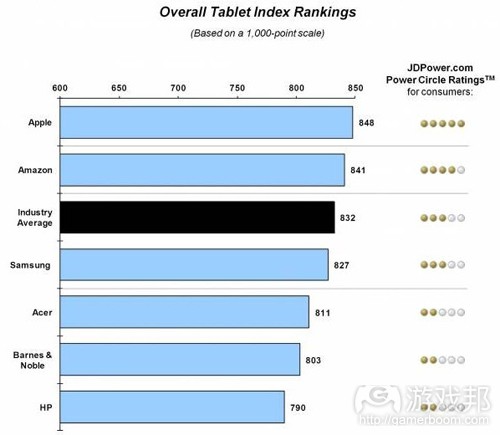每日观察:关注用户对平板电脑满意度及使用习惯(9.14)
1)IHS最新报告显示,2011年iPhone出货量为9300万部,预计iPhone 5的发布将推动苹果手机在今年突破1.49亿部的出货量(增长60%)。
原先有不少分析师称新iPhone将发布的传闻导致用户推迟购买iPhone的计划,这一现象可能导致第三季度的iPhone出货量从第二季度的3510万部降至2600万部。
IHS移动分析师Daniel Gleeson表示,与去年发布iPhone 4S时不同,今年的iPhone 5与之前的iPhone手机型号更具突破性,它是首款采用4G技术的苹果智能手机,其性能优化将提大提升iPhone 5销量。
2)IHS最新报告预测,2008年至2013年之间Android手机总体出货量将达11亿部(游戏邦注:Android操作系统于2008年进入市场),同一时期苹果iOS设备出货量将达5.27亿部。
2012年Android智能手机全年出货量将达3.57亿部,预计2013年将增长至4.51亿部。
3)芯片制造商Qualcomm最近预测,到2013年底,将有90%的智能手机用户使用云服务,预计到2014年智能手机将成为超越PC的云服务连接设备;在不久的将来,手机将可连接到周边其他电子设备,例如警报系统、洗衣机等。
4)据InMobi最新数据显示,平均每个德国移动网络用户每天消耗媒体内容的时间达6.5个小时,其中移动内容占据2小时5分钟。
与此同时,64%用户会在看电视的同时使用移动设备;76%女性用户会在床上使用这一设备,有同一使用习惯的男性用户占比65%。
87%用户在等待过程中使用手机上网打发时间,40%用户在购物时使用移动网络,38%用户在卫生间使用手机。
57%用户表示移动广告会引起他们注意,87%用户在不同平台发现广告,23%表示移动广告促使他们采取消费行动。
64%用户表示应用内置广告是他们最常注意到的移动广告类型,41%用户称自己在搜索引擎发现广告。
5)The Consumer Attitudes Audit from Future Poll调查报告显示,目前已有半数已上英国人至少拥有一台智能手机或者笔记本电脑,20%英国人认为拥有智能手机可以代表自己的生活水准居于贫困线之上。持有这一观念的用户已从18个月前的1%增长了20倍。
24%用户认为拥有笔记本电脑代表生活水准居于贫困线之上,而18个月前的这一比例为10%。
除此之外,44%用户认为Wi-Fi会决定你的富裕程度(原先的这一比例为30%),11%认为这一决定因素是游戏主机(原来的比例为3%),11%认为是MP3(原来的比例是2%)。
6)J.D. Power and Associates最近的平板电脑用户满意度调查显示,亚马逊及其平板电脑的用户评价高达842(满分为1000点),仅比苹果(848)低6个点数。这两者的得分均高于行业平均水准(832),三星、宏碁、Barnes & Noble和惠普得分虽然名列前茅,但都低于这一行业平均线。
在这1985名平板电脑用户受访者中,多数人认为更宽大的触摸屏更易让他们沉浸其中,他们对平板电脑的粘性也高于智能手机。
平板电脑用户平均每周在这一设备中投入时间达7.5小时,其中涉及的主要活动包括上网、看视频、听音乐、读书。但用户对其使用频率仍然低于PC(平均每周投入9.6小时)。
那些更常使用平板电脑的用户对这一设备的评价也相对更高,每周都在这一设备上至少看3小时视频的用户对其平均满意度为857,而对其使用频率较低的用户满意度为812。在前一种用户中,90%受访者更有可能在之后购买同一品牌的平板电脑,而那些使频率较低的用户也表现出了强大的品牌忠诚度,有81%表示会再购买同种品牌的设备。37%受访者计划在未来12个月购买新平板电脑。
调查还发现,同时持有平板电脑和智能手机的用户,在平板电脑上网的时间比在手机上多40%;在平板电脑上玩游戏应用的时间更是比在手机上多56%。25%用户表示自己将平板电脑用于办公。
7)据AllThingsD报道,一名苹果发言人最近确认了他们将不再支持iPhone 3GS的消息,苹果智能手机目前产品阵容分别是iPhone 4、iPhone 4S和iPhone 5。
尽管iPhone 3GS仍可升级至iOS 6,但它无法运行该系统中的某此功能,现在苹果智能手机的初级设备已经变成了iPhone 4。(本文为游戏邦/gamerboom.com编译,拒绝任何不保留版权的转载,如需转载请联系:游戏邦)
1)iPhone 5 to fuel record 149m Apple smartphone shipments in 2012
by Zen Terrelonge
A 60 per cent rise on last year.
iPhone shipments hit 93 million in 2011, and the newly unveiled iPhone 5 is expected to send total shipments for the year rocketing by 60 per cent and smash past 149m, according to IHS.
Traditionally, whispers of a new iPhone approaching prompts consumers to stave off buying the current design, which was the case this year when Q3 shipments hit 26m and fell from Q2′s 35.1m.
But the firm is expected to bounce back to record the biggest quarterly iPhone sales in history.
Daniel Gleeson, mobile analyst, IHS, said: “Unlike last year’s release of the iPhone 4S, this year’s iPhone 5 announcement comes as a significant departure from previous models.
“The addition of a new, larger screen is a fundamental change in product design. Furthermore, the iPhone 5 is the first member of Apple’s smartphone line to feature 4G long term evolution (LTE) connectivity, accelerating data speeds dramatically compared to previous models. These major improvements will drive strong sales for the iPhone 5.”(source:mobile-ent)
2)One billion Android phone shipments
by Mike Shaw
It’s iPhone in the news, but Android is taking over the world.
Android appeared on the market in 2008, but next year, IHS forecasts that shipments of phones using the Google OS will total more than one billion.
In 2013, worldwide annual shipments of Android smartphones will rise to 451 million, up from 357 million this year. These rapidly increasing figures mean that combined shipments since 2008 will total 1.1 billion by the end of 2013.
The same report forecasts that Apple’s iOS will have shipped 527 million units by the same point, not reaching one billion until 2015.
Daniel Gleeson, mobile analyst for IHS, said: “Such an open-source model means that Google offers handset makers the ability to customise Android easily, and by also eliminating licensing fees, is greatly encouraging adoption among smartphone handset manufacturers.”(source:mobile-ent)
3)90 per cent of smartphones will be cloud connected by 2013
by Mike Shaw
Qualcomm has some compelling ideas about where our digital lives are going.
Chipmaker Qualcomm says that nine out of ten smartphone users will be connected to a personal cloud in some form by the end of next year.
The remarks came at Qualcomm’s IQ Innovation summit in Berlin, where executives spoke about the likelihood of phones becoming the primary way we interact with our digital lives.
As well as predicting that smartphones will overtake PCs as cloud-connected devices by 2014, Qualcomm believes that in the near future, phones will connect with the majority of other nearby electronic devices, from alarm systems to washing machines.
Stephen Mollenkopf, COO, Qualcomm, said: “We want devices to react to what’s going on around you, to learn more about you, and then use it to improve your life.
“The phone looks at the environment around you” he explained, “Like a remote control for your life.”
According to Qualcomm, there are more mobile phones in the world than toothbrushes and the next step is an increase in the amount of people who interact with the cloud.
Qualcomm knows better than most where the industry is going. The company is already on its third generation of LTE chipsets, helping progress 4G mobile internet and make the process more energy efficient.
The company suggested that as more of the world goes mobile and LTE becomes prevalent, users could start using their smartphones for all web use, letting go of home broadband connections altogether.(source:mobile-ent)
4)Germans spend more time using mobiles than watching TV
by Zen Terrelonge
Average at around two hours vs 90 minutes each day.
The average German mobile web user spends six and a half hours consuming media each day, with mobile accounting for two hours and five minutes ahead of just 85 minutes for TV viewing, according to InMobi.
Meanwhile, 64 per cent of users use their devices while watching TV, which is stimulating the growing second-screen era. It’s a good thing though, as the trend gives advertisers a prime opportunity to target their ads to viewers.
The mobile dependency is higher with women, as 76 per cent use the devices in bed compared to 65 per cent of men.
Other times for mobile web usage includes 87 per cent doing so while waiting for something, 40 per cent while shopping, and 38 per cent when in the bathroom.
57 per cent of consumers say that mobile ads has brought something new to their attention and 87 per cent notice ads across different platforms, while 23 per cent have been encouraged to go and make an in-store buy.64 per cent say in-app ads are the most common ones they notice, showing the popularity of the freemium design model, while 41 per cent spot ads in search engines.(source:mobile-ent)
5)A fifth of Brits believe smartphones keep them above the poverty line
by Zen Terrelonge
A twenty-fold growth in 18 months.
A phone isn’t just a phone anymore. The birth of smartphones has made mobile a fashion accessory, a laptop, and a lifeline to the internet.
More than half of Brits now own one of the devices, and bizarrely they’re making people feel wealthy.
The Consumer Attitudes Audit from Future Poll shows that 20 per cent of Brits reckon households need a smartphone to live above the poverty line. The belief has surged twentyfold from just one per cent 18 months ago.
Comparatively, 24 per cent think laptops are required to steer clear of the poverty line, up from ten per cent 18 months ago. This suggests Brits believe smartphones offer a better show of affluence.
Additionally, 44 per cent think wi-fi determines your riches (up from 30 per cent), 11 per cent say games consoles (up from three per cent), and 11 per cent cite MP3 (up from two per cent).
Tom Savigar, chief strategy officer, The Future Laboratory, said: “Less than two years ago, 1 in 100 people believed smartphone ownership defined the poverty line – today 1 in 5 think so. It’s a truly astonishing admission of how advanced technology is now regarded as an essential staple of modern life, not a luxurious extra.”(source:mobile-ent)
6)Apple Tops J.D. Power’s Tablet Survey, Barely Beating Amazon; Tablets Top Smartphones For Usage
Ingrid Lunden
One day after Apple’s big iPhone 5 news day, an accolade for Apple in the tablet category: J.D. Power and Associates has put the brand at the top of its annual tablet customer satisfaction survey. This is the first time that the influential pollster has tracked U.S. consumers on tablet usage — it is known for its mobile handset rankings, which Apple also topped for smartphones last week. Amazon and its Kindle Fire tablet are, however, nipping at Apple’s heels: the two were separated by only six points, with Amazon scoring particularly well because of its low price. Final tallies for the two brands were Apple at 848 and Amazon at 842, on a scale of 1,000.
Both scored higher than the industry average of 832, with Samsung, Acer, Barnes & Noble and HP rounding out the top rankings in the list, all below the industry average.
In addition to ranking tablet brands, J.D. Power also looked at tablet usage. The 1,985 tablet owners who were polled reached conclusions that reflect what others have also been saying: the bigger touchscreen on tablets is making them a much stronger magnet for content consumption and user engagement than their smaller-sized smartphone cousins.
Tablet users are spending, on average, 7.5 hours per week on their devices, doing things like surfing the web, watching videos, listening to music, and reading books. That still puts it at a lower time than PCs, which clock up 9.6 hours of usage a week for the same activities.
Unsurprisingly, those who use their tablets more are also more satisfied with the tablet form factor. On a scale of 1,000, those who view three or more hours of video per week rated their satisfaction as 857, versus those who watched less rating at 812.
And the survey delivers a fairly clear message about the importance of getting the content right — in the form of apps and other services — for tablet makers’ bigger hardware businesses. Those who watch more than three hours of video are also 90% more likely to become repeat buyers of the same brand — the same percentage that said they would return to the brand if they were satisfied with it. However, those who watched less still seemed to show strong brand affinity, with 81% of them saying they would buy the same brand of tablet again. Some 37% of all respondents said they would be buying a new tablet in the next 12 months.
“As tablet computing, multimedia, display, and application offerings continue to evolve, their impact on usage patterns will continue to grow,” writes Dr. Uma S. Jha, senior director of mobile devices at J.D. Power and Associates. “Tablets are a force in the marketplace that offer a great alternative to laptops and netbooks.”
As tablets move more to becoming a replacement for people’s PCs, they have already passed smartphones in usage. The survey found that consumers who owned both tablets and smartphones spent 40% more time browsing the web on their tablets than they did on their phones. Gaming apps scored even higher, with 56% more time spent on tablets.
But it’s not just a consumer plaything: 25% of owners said they used their tablets for business. This, too, was something noted by Apple during its last quarterly results where it highlighted the rise of enterprise deals for its iPad. It’s something that we’ve heard anecdotally too from enterprise service companies.
In its tablet rankings, J.D. Power asks users to rate products in five categories and then weights them in different proportions: performance (26%), ease of operation (22%), styling and design (19%), features (17%), and price (16%). It notes that Apple’s score of 848 came largely from being the first in performance, ease of use, styling/design and features, while Amazon beat it out on price.
Indeed, while Amazon first entered the market with a $199 Kindle Fire, its latest line of tablets, announced only last week, pointed to the company moving into higher-end products, with the 8.9-inch HD model costing $499, comparable with Apple’s pricing. It will be interesting to see whether Amazon, going forward, will be able to hold its own against Apple in the other categories as it clearly will become less attractive on a pricing level.(source:techcrunch)
7)Apple confirms plans to discontinue iPhone 3GS
Ricardo Bilton
Wednesday’s iPhone 5 unveiling marked the birth of a bunch of new products from Apple, but it also came with some product deaths as well.
One of these is of the iPhone 3GS, which has passed into the world of gadget obsolescence, an Apple spokesperson confirmed to AllThingsD today. Apple’s smartphone lineup is now officially the iPhone 4, iPhone 4S, and iPhone 5.
Introduced at WWDC in June 2009, the third-generation iPhone survived two follow-up iterations of the iPhone, and saw four generations of iOS.
While the 3GS can be upgraded to iOS 6, the device isn’t capable of running all of the operating system’s features. This makes its discontinuation not only unsurprising but inevitable as well.
In its place as Apple’s entry-level smartphone is the iPhone 4, which is free on contract from AT&T, Verizon, and Sprint.(source:venturebeat)












































 闽公网安备35020302001549号
闽公网安备35020302001549号